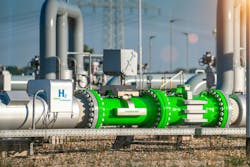City of Fresno Joins First Public Hydrogen Utility Infrastructure Network
The movement to create a first-ever public hydrogen-based utility in California has gained the biggest city within the agriculture-rich Central Valley as one of its foundational members.
The city of Fresno has joined First Public Hydrogen, or FPH2, to broaden the scope of hydrogen infrastructure and supply throughout the region. First Public Hydrogen was first created with the combination of the cities of Lancaster and Industry, which are located within the Antelope and San Gabriel valleys of Los Angeles County, respectively.
The announced goal of FPH2 is to create a viable and transparent market for the development and off-take of H2.
Hydrogen (H2 is its atomic number) does not contain carbon within its molecular chain and is among the most abundant elements on earth. It is not naturally mined on its own, so must be generated by multiple methods including steam reforming of methane natural gas–which separates methane’s one carbon atom from the four hydrogen atoms–or by electrolyzers which split the H2 from water.
H2 Infinity and Beyond
EnergyTech's free E-Book on the Future of Hydrogen
"Fresno's participation will further connect inland communities to the state's hydrogen network and strengthen local economies, support long-term infrastructure investment, and position the Central Valley as a leader in the next generation of energy technologies together with FPH2,” R. Rex Parris, chairman of the city of Fresno, said in a statement.
Fuel cells utilize an electrochemical process using gases to generate electricity without combustion or emissions except for water vapor. Many cities such as Fresno are looking to transition to zero-emission fleets by way of fuel cell electric or battery electric technologies.
"This partnership gives us a competitive edge as we expand our hydrogen-powered fleet, starting with FAX buses, by helping us access affordable fueling equipment and hydrogen fuel,” Fresno Mayor Jerry Dyer said.
Through its membership in FPH2, the city of Fresno seeks access to technical expertise, centralized procurement tools, and a transparent platform to collaborate with other public agencies and hydrogen providers. FPH2 members also help pilot early-stage hydrogen use cases, from municipal fleets to backup power systems.
The public California Energy Commission is investing in plans for an initial network of 100 hydrogen stations across the state. Infrastructure of hydrogen by pipeline is problematic because H2 is an energy-dense but light gas which may force adaptations in existing natural gas infrastructure.
The federal government has supported investment in regional Hydrogen Hubs across the country, including the Biden Administration’s Department of Energy expanding a 45V Clean Hydrogen Production Tax Credit up to $3 per kilogram. Recently, however, the Trump Administration and the Republican Congress passed a budget bill which ends the 45V tax credit for any projects which start construction in 2028 or later.
To be classified as “green hydrogen,” the H2 must be generated by electrolyzers powered by carbon-free electricity resources such as hydropower, solar, wind or nuclear. In Europe, H2 development has been advanced but many of those projects are focused on so-called “blue hydrogen,” in which the H2 is generated from carbon-intensive means such as steam reforming but then balanced by carbon capture and storage technologies.
Hydrogen Microgrids
It's a Thing: Read about it in Microgrid Knowledge
About the Author
Rod Walton, EnergyTech Managing Editor
Managing Editor
For EnergyTech editorial inquiries, please contact Managing Editor Rod Walton at [email protected].
Rod Walton has spent 17 years covering the energy industry as a newspaper and trade journalist. He formerly was energy writer and business editor at the Tulsa World. Later, he spent six years covering the electricity power sector for Pennwell and Clarion Events. He joined Endeavor and EnergyTech in November 2021.
Walton earned his Bachelors degree in journalism from the University of Oklahoma. His career stops include the Moore American, Bartlesville Examiner-Enterprise, Wagoner Tribune and Tulsa World.
EnergyTech is focused on the mission critical and large-scale energy users and their sustainability and resiliency goals. These include the commercial and industrial sectors, as well as the military, universities, data centers and microgrids. The C&I sectors together account for close to 30 percent of greenhouse gas emissions in the U.S.
He was named Managing Editor for Microgrid Knowledge and EnergyTech starting July 1, 2023
Many large-scale energy users such as Fortune 500 companies, and mission-critical users such as military bases, universities, healthcare facilities, public safety and data centers, shifting their energy priorities to reach net-zero carbon goals within the coming decades. These include plans for renewable energy power purchase agreements, but also on-site resiliency projects such as microgrids, combined heat and power, rooftop solar, energy storage, digitalization and building efficiency upgrades.

